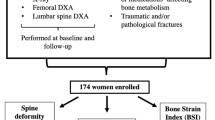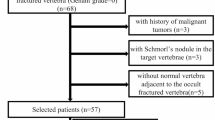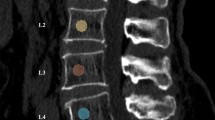Abstract
Purpose
There is emerging evidence that radiomics analyses can improve detection of skeletal fragility. In this cross-sectional study, we evaluated radiomics features (RFs) on computed tomography (CT) images of the lumbar spine in subjects with or without fragility vertebral fractures (VFs).
Methods
Two-hundred-forty consecutive individuals (mean age 60.4 ± 15.4, 130 males) were evaluated by radiomics analyses on opportunistic lumbar spine CT. VFs were diagnosed in 58 subjects by morphometric approach on CT or XR-ray spine (D4-L4) images. DXA measurement of bone mineral density (BMD) was performed on 17 subjects with VFs.
Results
Twenty RFs were used to develop the machine learning model reaching 0.839 and 0.789 of AUROC in the train and test datasets, respectively. After correction for age, VFs were significantly associated with RFs obtained from non-fractured vertebrae indicating altered trabecular microarchitecture, such as low-gray level zone emphasis (LGLZE) [odds ratio (OR) 1.675, 95% confidence interval (CI) 1.215–2.310], gray level non-uniformity (GLN) (OR 1.403, 95% CI 1.023–1.924) and neighboring gray-tone difference matrix (NGTDM) contrast (OR 0.692, 95% CI 0.493–0.971). Noteworthy, no significant differences in LGLZE (p = 0.94), GLN (p = 0.40) and NGDTM contrast (p = 0.54) were found between fractured subjects with BMD T score < − 2.5 SD and those in whom VFs developed in absence of densitometric diagnosis of osteoporosis.
Conclusions
Artificial intelligence-based analyses on spine CT images identified RFs associated with fragility VFs. Future studies are needed to test the predictive value of RFs on opportunistic CT scans in identifying subjects with primary and secondary osteoporosis at high risk of fracture.





Similar content being viewed by others
References
Osteoporosis prevention, diagnosis, and therapy (2001). JAMA 285(6):785–795. https://doi.org/10.1001/jama.285.6.785
Cooper C, Atkinson EJ, O’Fallon WM, Melton LJ 3rd (1992) Incidence of clinically diagnosed vertebral fractures: a population-based study in Rochester, Minnesota, 1985–1989. J Bone Mineral Res 7(2):221–227. https://doi.org/10.1002/jbmr.5650070214
Adachi JD, Adami S, Gehlbach S, Anderson FA Jr, Boonen S, Chapurlat RD, Compston JE, Cooper C, Delmas P, Díez-Pérez A, Greenspan SL, Hooven FH, LaCroix AZ, Lindsay R, Netelenbos JC, Wu O, Pfeilschifter J, Roux C, Saag KG, Sambrook PN, Silverman S, Siris ES, Nika G, Watts NB (2010) Impact of prevalent fractures on quality of life: baseline results from the global longitudinal study of osteoporosis in women. Mayo Clin Proc 85(9):806–813. https://doi.org/10.4065/mcp.2010.0082
Lems WF, Paccou J, Zhang J, Fuggle NR, Chandran M, Harvey NC, Cooper C, Javaid K, Ferrari S, Akesson KE (2021) Vertebral fracture: epidemiology, impact and use of DXA vertebral fracture assessment in fracture liaison services. Osteoporosis Int 32(3):399–411. https://doi.org/10.1007/s00198-020-05804-3
Prince RL, Lewis JR, Lim WH, Wong G, Wilson KE, Khoo BC, Zhu K, Kiel DP, Schousboe JT (2019) Adding lateral spine imaging for vertebral fractures to densitometric screening: improving ascertainment of patients at high risk of incident osteoporotic fractures. J Bone Mineral Res 34(2):282–289. https://doi.org/10.1002/jbmr.3595
Lindsay R, Pack S, Li Z (2005) Longitudinal progression of fracture prevalence through a population of postmenopausal women with osteoporosis. Osteoporosis Int 16(3):306–312. https://doi.org/10.1007/s00198-004-1691-5
Yamamoto M, Yamauchi M, Sugimoto T (2019) Prevalent vertebral fracture is dominantly associated with spinal microstructural deterioration rather than bone mineral density in patients with type 2 diabetes mellitus. PLoS ONE 14:e0222571. https://doi.org/10.1371/journal.pone.0222571
Wang J, Stein EM, Zhou B et al (2016) Deterioration of trabecular plate-rod and cortical microarchitecture and reduced bone stiffness at distal radius and tibia in postmenopausal women with vertebral fractures. Bone 88:39–46. https://doi.org/10.1016/j.bone.2016.04.003
Schousboe JT, Shepherd JA, Bilezikian JP, Baim S (2013) Executive summary of the 2013 International Society for Clinical Densitometry Position Development Conference on bone densitometry. J Clin Densitometry 16(4):455–466. https://doi.org/10.1016/j.jocd.2013.08.004
Griffith JF, Genant HK (2012) New advances in imaging osteoporosis and its complications. Endocrine 42(1):39–51. https://doi.org/10.1007/s12020-012-9691-2
Mirza F, Canalis E (2015) Management of endocrine disease: secondary osteoporosis: pathophysiology and management. Eur J Endocrinol 173(3):R131-151. https://doi.org/10.1530/eje-15-0118
Gillies RJ, Kinahan PE, Hricak H (2016) Radiomics: images are more than pictures. They are data. Radiology 278(2):563–577. https://doi.org/10.1148/radiol.2015151169
Lambin P, Leijenaar RTH, Deist TM, Peerlings J, de Jong EEC, van Timmeren J, Sanduleanu S, Larue R, Even AJG, Jochems A, van Wijk Y, Woodruff H, van Soest J, Lustberg T, Roelofs E, van Elmpt W, Dekker A, Mottaghy FM, Wildberger JE, Walsh S (2017) Radiomics: the bridge between medical imaging and personalized medicine. Nat Rev Clin Oncol 14(12):749–762. https://doi.org/10.1038/nrclinonc.2017.141
Rastegar S, Vaziri M, Qasempour Y, Akhash MR, Abdalvand N, Shiri I, Abdollahi H, Zaidi H (2020) Radiomics for classification of bone mineral loss: A machine learning study. Diagn Interv Imaging 101(9):599–610. https://doi.org/10.1016/j.diii.2020.01.008
Mookiah MRK, Subburaj K, Mei K, Kopp FK, Kaesmacher J, Jungmann PM, Foehr P, Noel PB, Kirschke JS, Baum T (2018) Multidetector computed tomography imaging: effect of sparse sampling and iterative reconstruction on trabecular bone microstructure. J Comput Assist Tomogr 42(3):441–447. https://doi.org/10.1097/rct.0000000000000710
Le Corroller T, Halgrin J, Pithioux M, Guenoun D, Chabrand P, Champsaur P (2012) Combination of texture analysis and bone mineral density improves the prediction of fracture load in human femurs. Osteoporosis Int 23(1):163–169. https://doi.org/10.1007/s00198-011-1703-1
Engelke K, Stampa B, Steiger P, Fuerst T, Genant HK (2019) Automated quantitative morphometry of vertebral heights on spinal radiographs: comparison of a clinical workflow tool with standard 6-point morphometry. Arch Osteoporos 14(1):18. https://doi.org/10.1007/s11657-019-0577-2
Crans GG, Genant HK, Krege JH (2005) Prognostic utility of a semiquantitative spinal deformity index. Bone 37(2):175–179. https://doi.org/10.1016/j.bone.2005.04.003
Zwanenburg A, Vallières M, Abdalah MA, Aerts HJWL, Andrearczyk V, Apte A, Ashrafinia S, Bakas S, Beukinga RJ, Boellaard R, Bogowicz M, Boldrini L, Buvat I, Cook GJR, Davatzikos C, Depeursinge A, Desseroit M-C, Dinapoli N, Dinh CV, Echegaray S, Naqa IE, Fedorov AY, Gatta R, Gillies RJ, Goh V, Götz M, Guckenberger M, Ha SM, Hatt M, Isensee F, Lambin P, Leger S, Leijenaar RTH, Lenkowicz J, Lippert F, Losnegård A, Maier-Hein KH, Morin O, Müller H, Napel S, Nioche C, Orlhac F, Pati S, Pfaehler EAG, Rahmim A, Rao AUK, Scherer J, Siddique MM, Sijtsema NM, Fernandez JS, Spezi E, Steenbakkers RJHM, Tanadini-Lang S, Thorwarth D, Troost EGC, Upadhaya T, Valentini V, Dijk LV, Griethuysen J, Velden FHP, Whybra P, Richter C, Löck S (2020) The image biomarker standardization initiative: standardized quantitative radiomics for high-throughput image-based phenotyping. Radiology 295(2):328–338. https://doi.org/10.1148/radiol.2020191145
Kanis JA, McCloskey EV, Johansson H, Cooper C, Rizzoli R, Reginster JY (2013) European guidance for the diagnosis and management of osteoporosis in postmenopausal women. Osteoporosis Int 24(1):23–57. https://doi.org/10.1007/s00198-012-2074-y
de Bakker CMJ, Tseng WJ, Li Y, Zhao H, Liu XS (2017) Clinical evaluation of bone strength and fracture risk. Curr Osteoporos Rep 15(1):32–42. https://doi.org/10.1007/s11914-017-0346-3
Schwaiger BJ, Kopperdahl DL, Nardo L, Facchetti L, Gersing AS, Neumann J, Lee KJ, Keaveny TM, Link TM (2017) Vertebral and femoral bone mineral density and bone strength in prostate cancer patients assessed in phantomless PET/CT examinations. Bone 101:62–69. https://doi.org/10.1016/j.bone.2017.04.008
Lee DC, Hoffmann PF, Kopperdahl DL, Keaveny TM (2017) Phantomless calibration of CT scans for measurement of BMD and bone strength-Inter-operator reanalysis precision. Bone 103:325–333. https://doi.org/10.1016/j.bone.2017.07.029
Pickhardt PJ, Lee SJ, Liu J, Yao J, Lay N, Graffy PM, Summers RM (2019) Population-based opportunistic osteoporosis screening: validation of a fully automated CT tool for assessing longitudinal BMD changes. Br J Radiol 92(1094):20180726. https://doi.org/10.1259/bjr.20180726
Jang S, Graffy PM, Ziemlewicz TJ, Lee SJ, Summers RM, Pickhardt PJ (2019) Opportunistic osteoporosis screening at routine abdominal and thoracic CT: normative L1 trabecular attenuation values in more than 20,000 adults. Radiology 291(2):360–367. https://doi.org/10.1148/radiol.2019181648
Lim HK, Ha HI, Park SY, Han J (2021) Prediction of femoral osteoporosis using machine-learning analysis with radiomics features and abdomen-pelvic CT: a retrospective single center preliminary study. PLoS ONE 16(3):e0247330. https://doi.org/10.1371/journal.pone.0247330
Valentinitsch A, Trebeschi S, Alarcón E, Baum T, Kaesmacher J, Zimmer C, Lorenz C, Kirschke JS (2017) Regional analysis of age-related local bone loss in the spine of a healthy population using 3D voxel-based modeling. Bone 103:233–240. https://doi.org/10.1016/j.bone.2017.06.013
Wang X, Sanyal A, Cawthon PM, Palermo L, Jekir M, Christensen J, Ensrud KE, Cummings SR, Orwoll E, Black DM, Keaveny TM (2012) Prediction of new clinical vertebral fractures in elderly men using finite element analysis of CT scans. J Bone Mineral Res 27(4):808–816. https://doi.org/10.1002/jbmr.1539
Valentinitsch A, Trebeschi S, Kaesmacher J, Lorenz C, Löffler MT, Zimmer C, Baum T, Kirschke JS (2019) Opportunistic osteoporosis screening in multi-detector CT images via local classification of textures. Osteoporosis Int 30(6):1275–1285. https://doi.org/10.1007/s00198-019-04910-1
Rachidi M, Marchadier A, Gadois C, Lespessailles E, Chappard C, Benhamou CL (2008) Laws’ masks descriptors applied to bone texture analysis: an innovative and discriminant tool in osteoporosis. Skeletal Radiol 37(6):541–548. https://doi.org/10.1007/s00256-008-0463-2
Valentinitsch A, Patsch JM, Burghardt AJ, Link TM, Majumdar S, Fischer L, Schueller-Weidekamm C, Resch H, Kainberger F, Langs G (2013) Computational identification and quantification of trabecular microarchitecture classes by 3-D texture analysis-based clustering. Bone 54(1):133–140. https://doi.org/10.1016/j.bone.2012.12.047
McCloskey EV, Odén A, Harvey NC, Leslie WD, Hans D, Johansson H, Barkmann R, Boutroy S, Brown J, Chapurlat R, Elders PJM, Fujita Y, Glüer CC, Goltzman D, Iki M, Karlsson M, Kindmark A, Kotowicz M, Kurumatani N, Kwok T, Lamy O, Leung J, Lippuner K, Ljunggren Ö, Lorentzon M, Mellström D, Merlijn T, Oei L, Ohlsson C, Pasco JA, Rivadeneira F, Rosengren B, Sornay-Rendu E, Szulc P, Tamaki J, Kanis JA (2016) A meta-analysis of trabecular bone score in fracture risk prediction and its relationship to FRAX. J Bone Mineral Res 31(5):940–948. https://doi.org/10.1002/jbmr.2734
Yokota K, Chiba K, Okazaki N, Kondo C, Doi M, Yamada S, Era M, Nishino Y, Yonekura A, Tomita M, Osaki M (2020) Deterioration of bone microstructure by aging and menopause in Japanese healthy women: analysis by HR-pQCT. J Bone Mineral Metabolism 38(6):826–838. https://doi.org/10.1007/s00774-020-01115-z
Genant HK, Delmas PD, Chen P, Jiang Y, Eriksen EF, Dalsky GP, Marcus R, San Martin J (2007) Severity of vertebral fracture reflects deterioration of bone microarchitecture. Osteoporosis Int 18(1):69–76. https://doi.org/10.1007/s00198-006-0199-6
Cellini M, Biamonte E, Mazza M, Trenti N, Ragucci P, Milani D, Ferrante E, Rossini Z, Lavezzi E, Sala E, Mantovani G, Arosio M, Fornari M, Balzarini L, Lania AG, Mazziotti G (2021) Vertebral fractures associated with spinal sagittal imbalance and quality of life in acromegaly: a radiographic study with EOS 2D/3D technology. Neuroendocrinology 111(8):775–785. https://doi.org/10.1159/000511811
Schwab F, Patel A, Ungar B, Farcy JP, Lafage V (2010) Adult spinal deformity-postoperative standing imbalance: how much can you tolerate? An overview of key parameters in assessing alignment and planning corrective surgery. Spine 35(25):2224–2231. https://doi.org/10.1097/BRS.0b013e3181ee6bd4
Giambini H, Wang HJ, Zhao C, Chen Q, Nassr A, An KN (2013) Anterior and posterior variations in mechanical properties of human vertebrae measured by nanoindentation. J Biomech 46(3):456–461. https://doi.org/10.1016/j.jbiomech.2012.11.008
Kanis JA, Johnell O, Oden A, Johansson H, McCloskey E (2008) FRAX and the assessment of fracture probability in men and women from the UK. Osteoporosis Int 19(4):385–397. https://doi.org/10.1007/s00198-007-0543-5
Funding
No funds, grants, or other support was received.
Author information
Authors and Affiliations
Corresponding author
Ethics declarations
Conflict of interest
The authors did not receive support from any organization for the submitted work. The authors have no relevant financial or non-financial interests to disclose.
Ethical approval
The Institutional Ethics Committee approved this retrospective study.
Research Involving Human Participants
All procedures in the present study that involved human participants were performed in accordance with the ethical standards of the Ethics Committee of the IRCCS Humanitas Clinical and Research Hospital (Milan, Italy) and the 1964 Helsinki declaration and its later amendments or comparable ethical standards.
Informed consent
Given the retrospective nature of the study, the Ethics Committee waived the informed consent from participants.
Additional information
Publisher's Note
Springer Nature remains neutral with regard to jurisdictional claims in published maps and institutional affiliations.
Supplementary Information
Below is the link to the electronic supplementary material.
Rights and permissions
About this article
Cite this article
Biamonte, E., Levi, R., Carrone, F. et al. Artificial intelligence-based radiomics on computed tomography of lumbar spine in subjects with fragility vertebral fractures. J Endocrinol Invest 45, 2007–2017 (2022). https://doi.org/10.1007/s40618-022-01837-z
Received:
Accepted:
Published:
Issue Date:
DOI: https://doi.org/10.1007/s40618-022-01837-z




